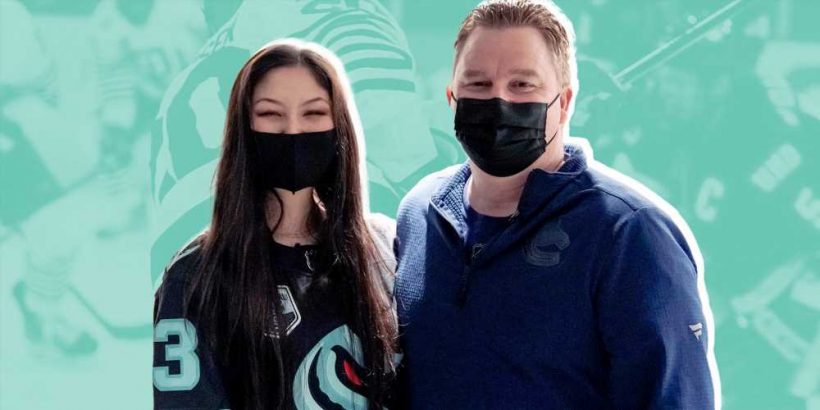A hockey fan is getting praise after encouraging an NHL team staff member to get a suspicious-looking mole on his neck checked out for cancer.
Nadia Popovici, a 22-year-old volunteer nursing assistant, was at a hockey game between the Vancouver Canucks and the Seattle Kraken on October 23 when she noticed an unusual mole on the neck of 47-year-old Brian Hamilton, an assistant equipment manager for the Canucks. According to The New York Times, the mole was about two centimeters, irregularly shaped, and red-brown in color, which are possible signs of skin cancer—signs she learned about during her volunteering. "I saw his [mole], and I was like, 'Wow, that is a picture perfect example of what a melanoma looks like,'" she said this past weekend as she was reflecting back on the situation, per the Associated Press (AP).
After debating about whether to say anything, Popovici typed a message on her phone that said, "The mole on the back of your neck is possibly cancerous. Please go see a doctor!," with the words "mole," "cancer," and "doctor" in red font. She tapped on the glass that separated Hamilton and his team from fans and showed it to the staffer as he was leaving the bench.
Hamilton said that the message "threw me off." "I kind of just shrugged and kept going," he recalled, per the AP. But the message did prompt Hamilton to show the mole to his girlfriend and eventually the team doctor, both of whom flagged it as suspicious. Hamilton had the mole removed and biopsied and learned that it was type-2 malignant melanoma. This stage of melanoma goes beyond the very outer layer of skin, into the thicker dermis layer of the skin, according to the Melanoma Research Alliance. Because it was caught early, the cancer could be removed and treated. "My initial response when I found out [it was cancer] was I felt bad because I felt like I didn't really give her the time of day," he said.
"She took me out of a slow fire," Hamilton said of Popovici at a recent press conference. "And the words out of the doctor's mouth were if I ignored that for four to five years, I wouldn't be here."
Even though Popovici alerted Hamilton about the mole during an October game, the story is making headlines now because Hamilton ended up going public with the story on the team's Twitter account on January 1 to thank Popovici. In the letter, Hamilton wrote that Popovici's "instincts were right" and "thanks to your persistence and the quick work of our doctors, [the cancer] is gone." "To this woman I am trying to find, you changed my life, and now I want to find you to say THANK YOU SO VERY MUCH!," he wrote in the letter. "Problem is, I don't know who you are or where you are from."
Popovici was tracked down and invited to meet Hamilton at this past Saturday's game between the Canucks and Kraken in Seattle. She was also given a $10,000 scholarship from both teams to use for her medical school expenses. "Some people are saying this is not even going to be a drop in the bucket, but trust me, it feels like everything," Popovici said, per The New York Times. "I'm really just so grateful."
Hamilton said he's not even sure how Popovici saw the mole, which he didn't even know existed. "How she saw it boggles my mind," he said, per the AP. "It wasn't very big. I wear a jacket. I wear a radio on the back of my jacket that hooks on so the cords are there." But her actions made "a true life-changing difference for me and my family," he wrote in the public letter.
How can you tell if a mole is dangerous?
In part, Hamilton's goals with going public with the story by publishing the letter on the team's Twitter was to find Popovici and thank her. Another reason he went public with the story was so that he could help spread awareness about melanoma, he said during the press conference.
First, it's important to know the ABCDEs of melanoma. As Health previously reported, those specifically stand for:
A: Asymmetry—If you drew a line down the middle of the spot, the two sides wouldn't match.
B: Border—The spot has an uneven, squiggly edge.
C: Color—The spot has subtle shading differences within the mole, or colors other than brown or black, like red or blue.
D: Diameter—Melanomas are usually larger than a quarter-inch, or about the size of a pencil eraser, when diagnosed, but they can be smaller.
E: Evolving—The spot looks different or is changing in size, shape, or color.
It was the first four of these signs that Popovici recognized in Hamilton's mole that compelled her to bring the spot to his attention. But not everyone is going to have someone like Popovici to warn them. That's why regular self-checks between your dermatologist appointments are key—and if you can get a friend or family member to take a look at those hard-to-see areas for you, even better.
"As soon as you see something unusual you should get it checked out, and as soon as you get a diagnosis, you need to be on top of the appropriate treatment," Noelani González, MD, an instructor of dermatology at the Mount Sinai Icahn School of Medicine in New York City, previously told Health. That's because melanoma tends to a very aggressive form of cancer, and it can progress quickly from one stage to another.
Thankfully, most melanomas are diagnosed in early, localized stages, according to Dr. González, and most patients treated for melanoma make a full recovery, as was the case in this story. "But we do have patients that have ignored that funny-looking mole for way too long, and it's not uncommon to see cases that have metastasized to other organs," she said.
Besides knowing the look of a potentially cancerous mole, it's also important to know its risk factors. Ultraviolet (UV) light exposure (especially via indoor tanning), having fair skin and light hair, and having a close relative who's also had melanoma are all risk factors for developing melanoma yourself.
But whether or not you're at higher risk for skin cancer, it's key to monitor your skin for abnormal growths and changes. "Going to see your board-certified dermatologist yearly and doing regular skin exams may not seem that important, but these are the things that could save your life," Dr. González said.
In this story, it's Popovici's knowledge about the ABCDEs of melanoma that potentially saved Hamilton's life, and he wants people to focus on her good deed. "I understand I'm a part of the story, but she needs to know she's the story," he said, per the AP. "She's the person that did this. She saved the life… She needs to know her efforts were valid and bang on."
Source: Read Full Article


